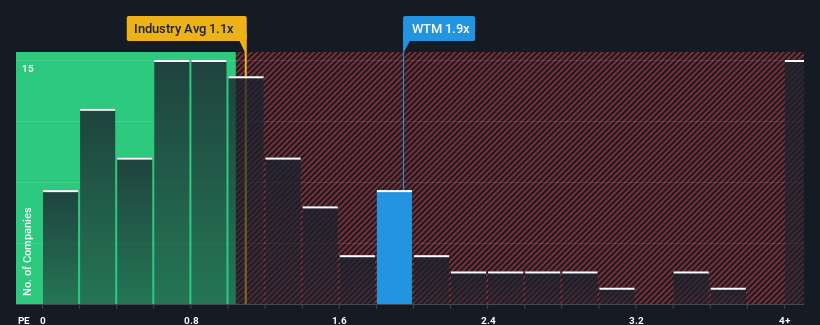- United States
- /
- Insurance
- /
- NYSE:WTM
What You Can Learn From White Mountains Insurance Group, Ltd.'s (NYSE:WTM) P/S

When close to half the companies in the Insurance industry in the United States have price-to-sales ratios (or "P/S") below 1.1x, you may consider White Mountains Insurance Group, Ltd. (NYSE:WTM) as a stock to potentially avoid with its 1.9x P/S ratio. Although, it's not wise to just take the P/S at face value as there may be an explanation why it's as high as it is.
Check out our latest analysis for White Mountains Insurance Group

What Does White Mountains Insurance Group's P/S Mean For Shareholders?
Recent times have been quite advantageous for White Mountains Insurance Group as its revenue has been rising very briskly. The P/S ratio is probably high because investors think this strong revenue growth will be enough to outperform the broader industry in the near future. However, if this isn't the case, investors might get caught out paying too much for the stock.
Want the full picture on earnings, revenue and cash flow for the company? Then our free report on White Mountains Insurance Group will help you shine a light on its historical performance.Do Revenue Forecasts Match The High P/S Ratio?
There's an inherent assumption that a company should outperform the industry for P/S ratios like White Mountains Insurance Group's to be considered reasonable.
If we review the last year of revenue growth, the company posted a terrific increase of 60%. The strong recent performance means it was also able to grow revenue by 70% in total over the last three years. Accordingly, shareholders would have definitely welcomed those medium-term rates of revenue growth.
This is in contrast to the rest of the industry, which is expected to grow by 5.2% over the next year, materially lower than the company's recent medium-term annualised growth rates.
With this information, we can see why White Mountains Insurance Group is trading at such a high P/S compared to the industry. It seems most investors are expecting this strong growth to continue and are willing to pay more for the stock.
The Final Word
Typically, we'd caution against reading too much into price-to-sales ratios when settling on investment decisions, though it can reveal plenty about what other market participants think about the company.
We've established that White Mountains Insurance Group maintains its high P/S on the strength of its recent three-year growth being higher than the wider industry forecast, as expected. In the eyes of shareholders, the probability of a continued growth trajectory is great enough to prevent the P/S from pulling back. Unless the recent medium-term conditions change, they will continue to provide strong support to the share price.
And what about other risks? Every company has them, and we've spotted 1 warning sign for White Mountains Insurance Group you should know about.
If strong companies turning a profit tickle your fancy, then you'll want to check out this free list of interesting companies that trade on a low P/E (but have proven they can grow earnings).
Valuation is complex, but we're here to simplify it.
Discover if White Mountains Insurance Group might be undervalued or overvalued with our detailed analysis, featuring fair value estimates, potential risks, dividends, insider trades, and its financial condition.
Access Free AnalysisHave feedback on this article? Concerned about the content? Get in touch with us directly. Alternatively, email editorial-team (at) simplywallst.com.
This article by Simply Wall St is general in nature. We provide commentary based on historical data and analyst forecasts only using an unbiased methodology and our articles are not intended to be financial advice. It does not constitute a recommendation to buy or sell any stock, and does not take account of your objectives, or your financial situation. We aim to bring you long-term focused analysis driven by fundamental data. Note that our analysis may not factor in the latest price-sensitive company announcements or qualitative material. Simply Wall St has no position in any stocks mentioned.
Have feedback on this article? Concerned about the content? Get in touch with us directly. Alternatively, email editorial-team@simplywallst.com
About NYSE:WTM
White Mountains Insurance Group
Through its subsidiaries, provides insurance and other financial services in the United States.
Adequate balance sheet very low.
Similar Companies
Market Insights
Community Narratives


